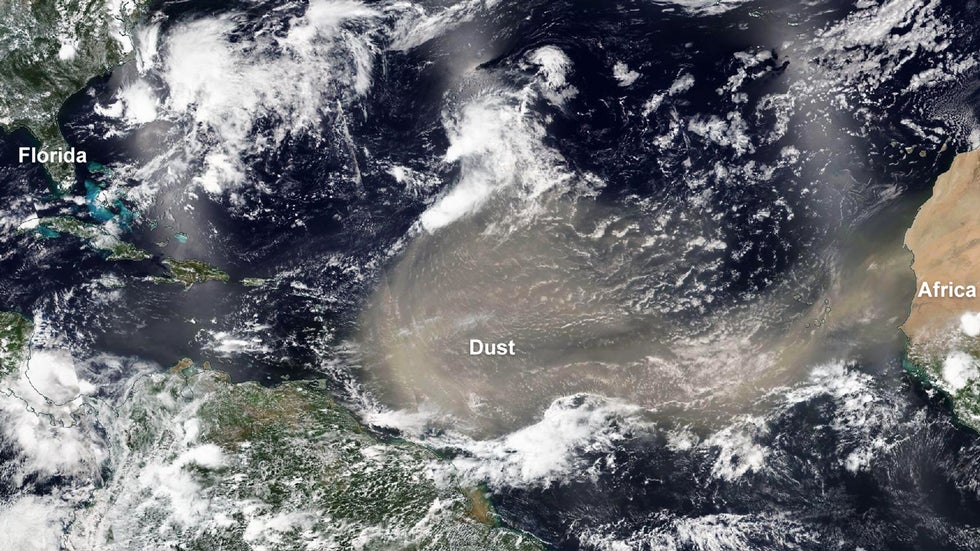Chris Dolce
Saharan dust outbreaks over the Atlantic are predicted to decrease because of ocean warming from climate change over the next century.
Bouts of dusty air of varying concentrations track thousands of miles from Africa to as far west as the Caribbean Sea, Florida and the Gulf of Mexico each year. These dust plumes are expected to decrease to a 20,000-year low over the next century, according to new research from NASA.
Known as the Saharan Air Layer (SAL), these dry dust plumes commonly form from late spring through early fall and move into the tropical Atlantic Ocean every three to five days, according to NOAA's Hurricane Research Division (HRD).
Get Ready For Summer With These On Sale Items (SPONSORED)
The HRD says the Saharan Air Layer is typically located between 5,000 and 20,000 feet above the Earth's surface. It is transported westward by bursts of strong winds and low-pressure disturbances known as tropical waves located in the central and western Atlantic Ocean at altitudes between 6,500 and 14,500 feet.
Below, you can see a computer model forecast depiction of dust plumes tracking through the Atlantic Basin in June 2020.
 Computer model forecast simulation of dust tracking across the Atlantic, Caribbean and Gulf of Mexico over multiple days in June 2020.
Computer model forecast simulation of dust tracking across the Atlantic, Caribbean and Gulf of Mexico over multiple days in June 2020.The trade winds responsible for sending this dust westward through the Atlantic could decrease in the future climate, which means less dust would be picked up from Africa.
"Sea surface temperatures directly impact wind speeds, so when the northern Atlantic warms relative to the south Atlantic, the trade winds that blow the dust from east to west become weaker. As a result, the slower winds pick up and transport less dust from the Sahara," NASA said.
Another factor that could curtail the transport of dust is the weakened trade winds opening the door for a band of rain or thunderstorms in the tropics to migrate farther into parts of the Sahara. That could make the dust somewhat wetter and cause it to be less susceptible to being lofted into the air.
 Satellite view of Saharan dust spreading across the Atlantic on June 20, 2020.
Satellite view of Saharan dust spreading across the Atlantic on June 20, 2020.Upwards of 60 million tons of African dust is sent into the atmosphere annually in the current climate, according to NASA.
There is expected to be a 30% decrease in the amount of dust picked up from Africa in the next 20 to 50 years, based on model data the NASA research team used from the Coupled Model Intercomparison Project 5 (CMIP5). Dust activity is predicted to continue declining beyond that time.
Saharan dust has both positive and negative impacts in areas where it is deposited.
Nutrients in the dust can help feed marine life in the ocean and plant life on land, NASA said.
Be Prepared For Emergencies With These Safety Items (SPONSORED)
Iron and phosphorus in the African dust help act as fertilizer in the Amazon rainforest. This is an important source of nutrients for the Amazon since phosphorous is limited in the region because rainfall sends it from the forest floor into nearby streams or rivers.
Occasionally, the Caribbean experiences unhealthy air quality when dust concentrations are high. Less dust would mean decreasing impacts to air quality in the future.
Algal blooms fed by dust near Florida could also be less harmful in the future.
Saharan Air Layer and Hurricane Season
Given the SAL is most common during hurricane season, research has been done on how it can affect the development of tropical storms and hurricanes. According to NOAA, some of the potential impacts to tropical development caused by the SAL include:
- The dry air can create downdrafts (sinking air) around tropical storms and hurricanes, which may result in the weakening of tropical cyclones.
- Strong winds associated with the SAL can contribute to increased vertical wind shear – the change in wind speed with height – which makes the environment hostile for tropical cyclone development.
- The role dust plays in tropical storm and hurricane intensity is not known. However, some research says it might impact cloud formation.
The Weather Company’s primary journalistic mission is to report on breaking weather news, the environment and the importance of science to our lives. This story does not necessarily represent the position of our parent company, IBM.
The Weather Company’s primary journalistic mission is to report on breaking weather news, the environment and the importance of science to our lives. This story does not necessarily represent the position of our parent company, IBM.

No comments:
Post a Comment